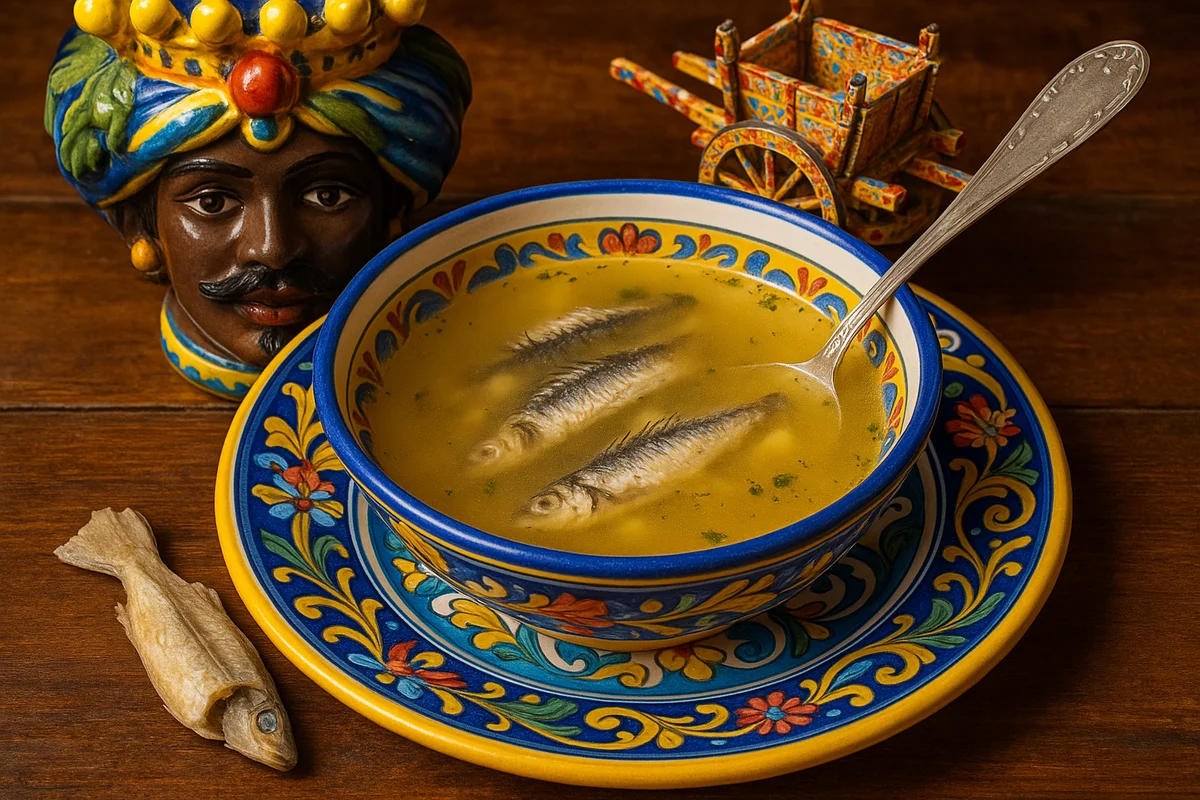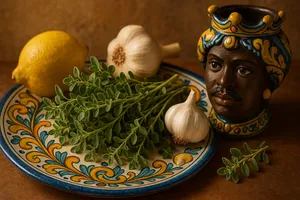Overview
Fish stock, called in Sicilian “vrodu 'i pisci” or “fumetto”, is a fundamental preparation of the island’s maritime cuisine, an indispensable base for soups, risottos and countless dishes belonging to the coastal gastronomic tradition. This highly aromatic liquid, amber in colour and intensely redolent of the sea, represents the very essence of Sicilian fish cookery, capable of transforming simple preparations into rich and complex dishes.
In the tradition of Sicilian fishing communities, fish stock was and still is prepared using the remnants from cleaning fish—heads, bones and trimmings—together with small rock fish, following the “nothing is wasted” principle typical of humble cookery. This approach has given rise to a precious ingredient, symbolic of a gastronomic culture that knows how to make full use of every element of the sea.
Characteristics
A well-prepared fish stock appears in a colour ranging from pale gold to amber, clear or slightly hazy. Its aroma is intense and distinctive, with fresh marine notes, hints of crustaceans and the fragrance of the vegetables and herbs used in its preparation.
The flavour is complex and layered: savoury thanks to the natural salinity of the fish, slightly sweet from the vegetables, with a lingering aftertaste reminiscent of the sea. The texture should be silky, never overly fatty, with body provided by the natural gelatin contained in fish heads, bones and cartilages.
Traditional ingredients
Sicilian fish stock is traditionally prepared using a combination of different fish to achieve a complex flavour. Rock fish such as scorpionfish, red mullet, gurnard, weaver fish and various small species are ideal, as they provide richness and gelatin.
Fish heads, particularly those of gilthead bream, sea bass, dentex and grouper, are extremely valuable because they contain abundant gelatin and flavour. Crustaceans such as prawns, langoustines and crabs also contribute fragrance and body.
The classic vegetables are celery, carrot, onion and fresh tomato, while essential herbs include parsley, bay leaf and sometimes wild fennel, typical of Sicily. Dry white wine and a drizzle of extra-virgin olive oil complete the traditional recipe.
Traditional preparation
The traditional Sicilian method begins with thorough cleaning of fish, heads and bones, removing gills and entrails which would make the stock bitter. They are rinsed well under running water to remove all traces of blood.
In a large pot, a chopped mixture of celery, carrot and onion is gently sautéed in extra-virgin olive oil. The fish and heads are then added and lightly browned. Dry white wine is poured in to deglaze, allowing the alcohol to evaporate.
Cold water is added to cover, along with chopped tomato and herbs, then brought slowly to the boil. Once boiling, the heat is reduced to the lowest possible setting and the stock is left to simmer gently for 40–60 minutes, skimming impurities that rise to the surface.
Unlike meat stock, fish stock does not require long cooking: one hour is enough to extract all its flavour and gelatin. Longer cooking may introduce bitterness. The stock is strained through a fine-meshed sieve or a clean cloth, discarding fish and vegetables that have fulfilled their role.
Use in the kitchen
In Sicilian cookery, fish stock is a versatile ingredient essential to many traditional preparations.
Fish soups
Fish stock is the base of fish soups and broths typical of Sicily’s coasts. It is used to cook whole fish or pieces, mussels, clams and squid, producing rich soups served with slices of toasted bread rubbed with garlic.
Seafood risottos
A good seafood risotto or risotto “allo scoglio” requires excellent fish stock, added ladle by ladle as the rice cooks. It lends creaminess and depth of flavour that water could never provide.
Pasta cooked in fish stock
In some areas of Sicily, pasta is cooked directly in concentrated fish stock, creating a simple yet intensely flavourful first course, often enriched with shellfish.
Cooking fish
Fish stock is used to braise or stew larger fish such as grouper, dentex or swordfish, keeping their flesh tender and full of flavour.
Sauces for pasta
It is added to fish sauces to give greater body and flavour, diluting concentrated tomato or loosening preparations that would otherwise be too dry.
Regional variations
Across Sicily, numerous variations of fish stock exist depending on local traditions and the catch available. In the area of Trapani and the Egadi Islands, rock fish are used extensively and wild fennel is added for a more intense aroma.
Along the eastern coast, from Catania to Syracuse, it is common to enrich the stock with shellfish and crustaceans, which provide a sweeter, more delicate flavour. In Palermo, a richer version is preferred, with the addition of red mullet and scorpionfish, giving a rosier colour and more structured flavour.
In some traditional recipes, the fish are lightly roasted in the oven before being used for the stock, a technique that imparts a more intense flavour and a darker colour.
Storage
Fresh fish stock keeps in the refrigerator for up to 2–3 days when stored in well-covered glass or food-grade plastic containers. It is important to cool it quickly after preparation and store it in the coldest part of the refrigerator.
For longer storage, it may be frozen in portions using rigid containers or freezer bags. It keeps for 2–3 months without significant loss of quality. Freezing it in ice-cube trays is also useful for having small amounts readily available for seasoning.
Before using stored stock, it should be brought to the boil for a few minutes, whether refrigerated or thawed, to ensure food safety.
Nutritional properties
Fish stock is light yet very nutritious, containing around 15–25 calories per 100 ml. It is rich in high-quality proteins that are easily absorbed and contains numerous minerals such as iodine, essential for the thyroid, phosphorus, calcium and magnesium.
It also provides B vitamins and beneficial substances derived from the gelatin and collagen in fish bones, heads and cartilage. Like meat stock, fish stock contains glucosamine, which is beneficial for the joints.
It is easily digested and therefore suitable for children, the elderly and those with digestive difficulties. In Sicilian folk tradition it was considered a natural restorative, given to those recovering from illness for its nutrient richness.
Tips for perfect stock
To obtain excellent fish stock, it is essential to use the freshest fish possible, ideally caught the same day. Meticulous cleaning is key: gills and entrails must be completely removed as they impart bitterness.
The variety of fish used matters: combining rock fish, heads of prized fish and a few crustaceans will produce a more complex and interesting result. The stock should never boil vigorously: it must simmer gently to extract flavour without clouding the liquid.
The white wine used should be of good quality, dry and not overly aromatic, so as not to overpower the delicate marine aromas. Salt must be added with care, bearing in mind that fish naturally releases salinity.
Common mistakes to avoid
The most common mistake is using fish that is not fresh or poorly stored, which will give the stock an unpleasant smell and flavour. Another frequent oversight is failing to clean the fish properly, especially the gills, which make the stock bitter.
Excessive cooking can compromise the result: unlike meat stock, fish stock requires shorter cooking times. Using overly fatty fish such as mackerel or sardines can also be problematic, giving an excessively strong and overpowering flavour.
It is important not to add too many herbs, which would mask the delicate marine aromas: fish stock should taste of the sea, not of the vegetable garden.
Curiosities
In Sicilian fishing communities, fish stock was traditionally made from the smallest fish caught in the nets, those without commercial value but which, combined, produced an exceptionally flavourful broth. This practice illustrates how humble cookery could transform “scraps” into delicacies.
An old Sicilian seafaring saying goes: “Cu' havi bon vrodu 'i pisci, po' fari 'na festa” (Whoever has good fish stock can prepare a feast), highlighting how this ingredient was regarded as the foundation for dishes suitable for special occasions.
In Sicilian seaside trattorias, fish stock is prepared daily at dawn using the catch just landed. The aroma that wafts from the kitchen is considered the best invitation for customers, an unmistakable sign of the freshness and quality of the fish used.
In some coastal areas of Sicily, especially in the Aeolian Islands and Pantelleria, there is a tradition of serving fish stock as a single dish, hot and steaming, with the addition of garlic-rubbed croutons. This simple yet deeply flavourful soup was the daily meal of fishermen, eaten even at sea after fishing.
The preparation of fish stock was considered an art passed down by the women of fishermen’s families. Each family had its own secret recipe, with particular proportions and techniques that made every stock unique and recognisable.











